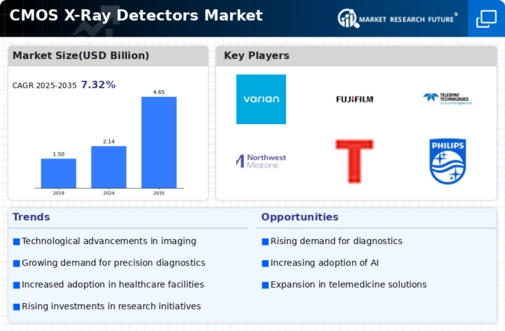Regulatory Compliance and Standards
The regulatory landscape surrounding medical imaging technologies is evolving, which impacts the CMOS X-Ray Detectors Market. Compliance with stringent regulations ensures that devices meet safety and efficacy standards, thereby fostering consumer trust. Regulatory bodies are increasingly emphasizing the need for advanced imaging solutions that minimize patient exposure to radiation while maintaining high diagnostic quality. This trend is likely to drive manufacturers to innovate and enhance their product offerings. As a result, the market is expected to witness a steady increase in demand for compliant CMOS X-Ray detectors. The emphasis on regulatory compliance not only influences product development but also shapes market dynamics, as companies that adhere to these standards are more likely to gain a competitive edge in the CMOS X-Ray Detectors Market.
Rising Awareness of Health and Safety
There is a growing awareness of health and safety standards, which is influencing the CMOS X-Ray Detectors Market. As patients and healthcare providers become more conscious of the risks associated with radiation exposure, the demand for advanced imaging technologies that minimize these risks is increasing. CMOS X-Ray detectors, known for their lower radiation doses compared to traditional detectors, are becoming more appealing in this context. This heightened awareness is likely to drive the adoption of CMOS technology in medical facilities, as practitioners seek to provide safer diagnostic options. The market is expected to respond positively to this trend, with an increase in the uptake of CMOS X-Ray detectors as healthcare providers prioritize patient safety and quality of care.
Technological Advancements in Imaging
The CMOS X-Ray Detectors Market is experiencing a surge in technological advancements that enhance imaging capabilities. Innovations in sensor technology, such as improved pixel resolution and dynamic range, are driving the adoption of CMOS detectors. These advancements allow for higher-quality images with reduced radiation exposure, which is particularly appealing in medical applications. The market is projected to grow at a compound annual growth rate of approximately 8% over the next five years, driven by these technological improvements. Furthermore, the integration of artificial intelligence in image processing is expected to streamline workflows and improve diagnostic accuracy, thereby increasing the demand for CMOS X-Ray detectors. As healthcare providers seek to upgrade their imaging systems, the CMOS X-Ray Detectors Market stands to benefit significantly from these ongoing advancements.
Increased Demand for Digital Solutions
The shift towards digital solutions in healthcare is a key driver for the CMOS X-Ray Detectors Market. As healthcare facilities increasingly adopt digital imaging technologies, the demand for CMOS X-Ray detectors is expected to rise. Digital solutions offer numerous advantages, including enhanced image quality, faster processing times, and improved data management capabilities. The market for digital X-Ray systems is projected to grow significantly, with estimates suggesting a growth rate of around 7% annually. This trend is further fueled by the need for remote diagnostics and telemedicine, which require high-quality imaging solutions. Consequently, the CMOS X-Ray Detectors Market is likely to see a robust increase in demand as healthcare providers transition to digital platforms.
Growing Applications in Various Sectors
The versatility of CMOS X-Ray detectors is expanding their applications across various sectors, which is a notable driver for the CMOS X-Ray Detectors Market. Beyond traditional medical imaging, these detectors are increasingly utilized in industrial applications, security screening, and research. For instance, in the industrial sector, CMOS X-Ray detectors are employed for non-destructive testing, ensuring product quality and safety. This diversification of applications is expected to contribute to market growth, as industries seek efficient and reliable imaging solutions. The increasing adoption of CMOS technology in diverse fields indicates a promising future for the CMOS X-Ray Detectors Market, as it adapts to meet the needs of various sectors.


















Leave a Comment